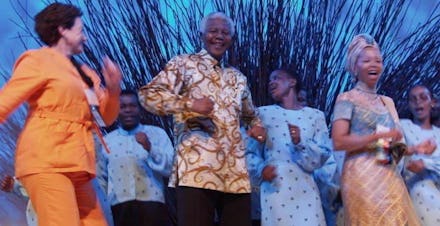The Nelson Mandela 'Shuffle' Will Be One of His Great Legacies

With recent news that Nelson Mandela is still unable to speak or move, I am reminded of his music and dance skills. Many know Mandela as prisoner number 46664, a president, a peacemaker, a hero, and a global icon for multiracialism and reconciliation. He gave his ultimate best to the fight for freedom and a multiracial South Africa, and he remains a symbol of hope for the world.
But amid all these superhuman achievements, Mandela never hid his natural, human side: The man can move.
He is a music lover and a dancer who always welcomed an opportunity to publicly display his talent in these regards. In fact, Mandela might not have had a choice; music and dance were an intimate part of the freedom struggle spearheaded by the African National Congress (ANC), which Mandela led. Like the African spiritual songs of the American Civil Rights movement, the freedom songs of the South African struggle against apartheid offered both hope and entertainment.
One thing most people don't know about Mandela is that he was a big fan of Ladysmith Black Mambazo, an African a cappella group also born out of the struggle against apartheid. Mandela crowned the group the "cultural ambassadors" of South Africa and ensured that they followed him on every major international invitation. In 1993, he requested that the group accompany him to his Nobel Peace Prize ceremony in Oslo, Norway. They sang for him at his inauguration as president of South Africa and also accompanied him to an invitation by Queen Elizabeth II. In 2003, Mandela again called on Ladysmith to serve as ambassadors for his HIV/AIDS awareness campaign, 46664. Like griots, they followed him to almost every major world event.
The founder of Ladysmith, Joseph Shabalala, even wrote a song for Mandela entitled Long Wa To Freedom. According to Shabalala, he dedicated the song to Mandela because he conquered each and everything around the world. Those people who were hesitating about him, they started to come next to him.
His iconic dance is dubbed the Mandela Shuffle; it's well known to some of us, but does it pass the African test for rhythm and dance?
The shuffle entails forming a double fist and raising both arms in a curved position, lightly shaking the body, and moving the legs around the knees. The Shuffle is more akin to his training as a boxer than as a dancer.
But while Mandela’s legacy might not weigh heavily on the shuffle, the move itself is basic and agreeably entertaining. In fact, the Shuffle goes quite well with many South African freedom songs, and for post-Robben Island Mandela, it was the one and only move, no matter the beat.
Perhaps what matters most is not the technicalities of Mandela’s dance moves, but the courage and laxity with which he did them. Nietzsche wrote in Thus Spoke Zarathustra that he would only believe in a God that knows how to dance. Mandela is no god and probably not the best of dancers, but he applied what skills he had to mingle with his people. And in his own words, it is music and dance that makes him at peace with the world and himself.
In spite of all the struggles he experienced in his life, Mandela also found time to sing and dance, and that makes the shuffle another one of his great legacies.